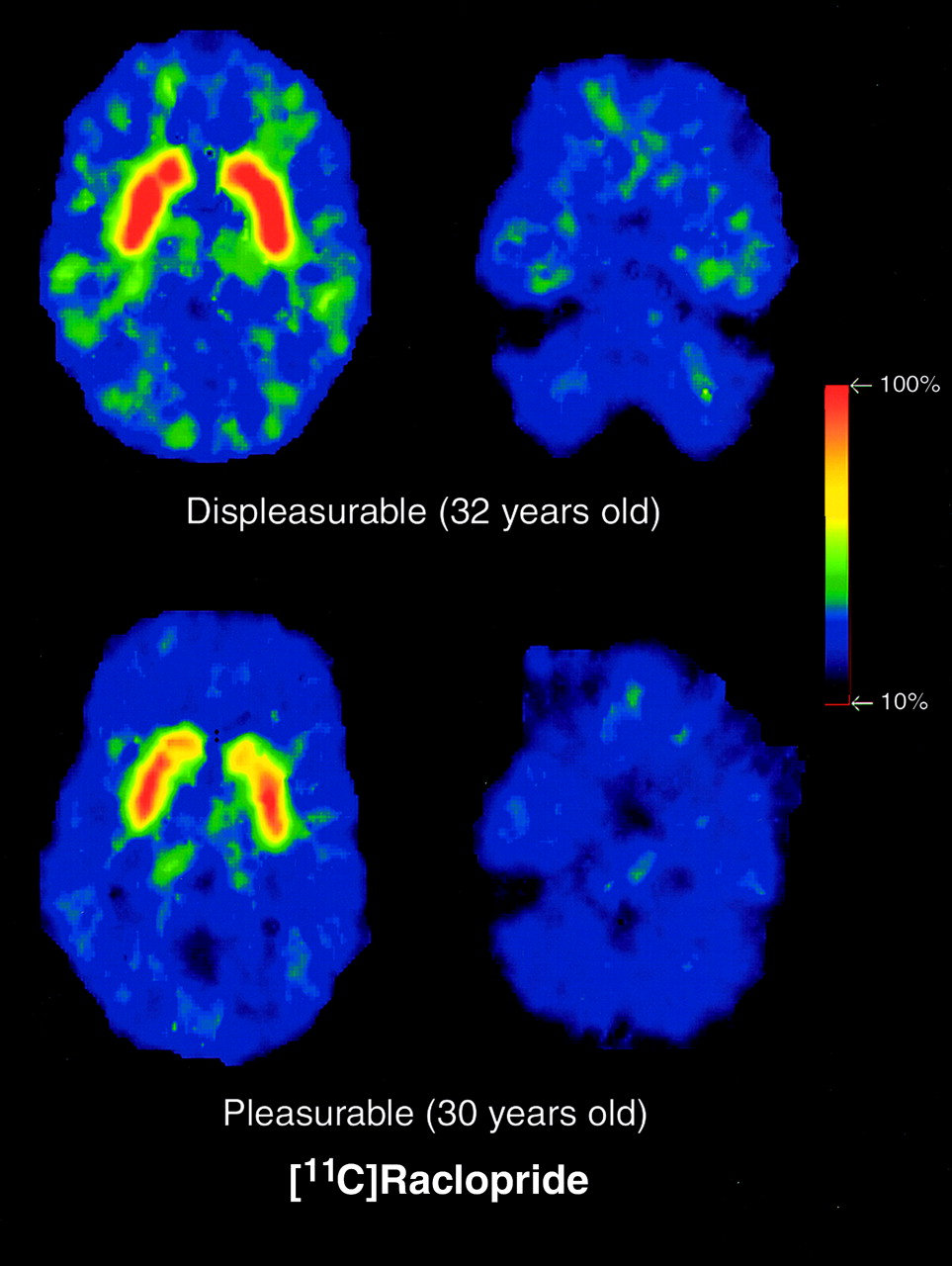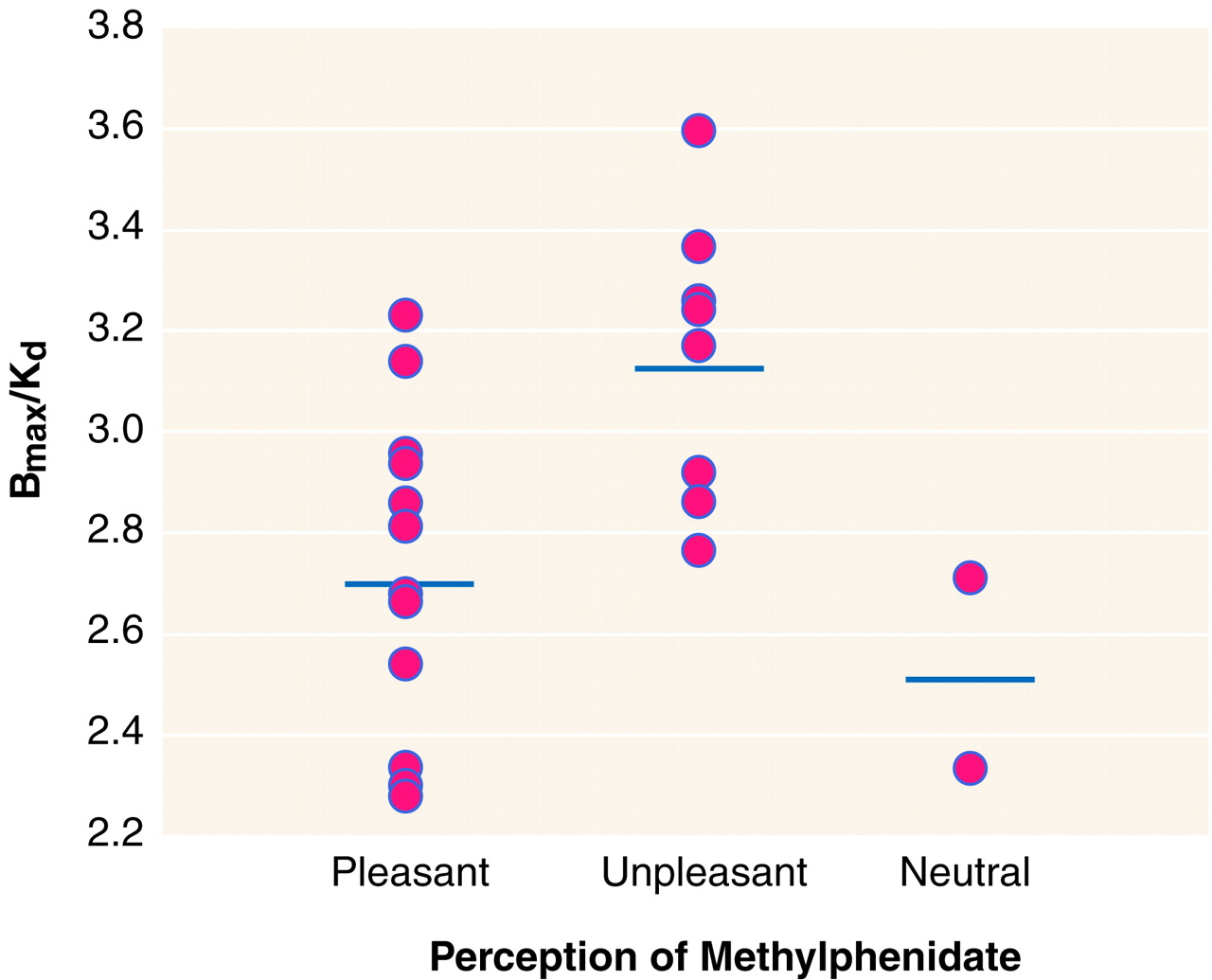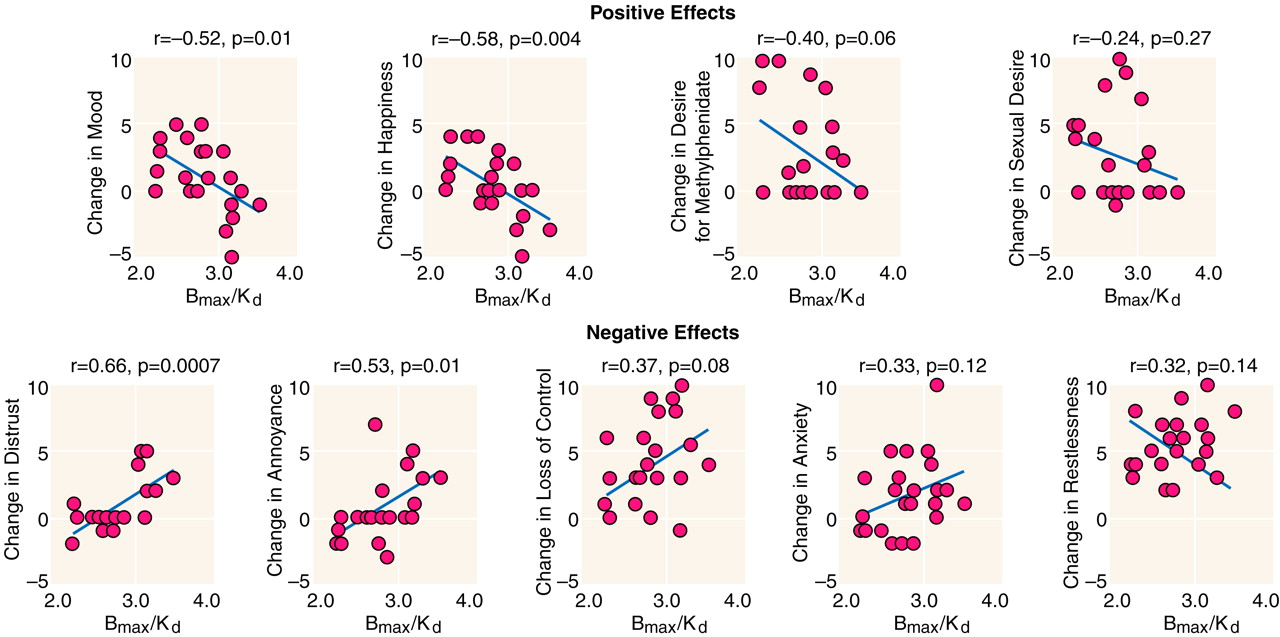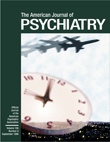One of the most challenging problems in the neurobiology of drug addiction is understanding why some individuals abuse drugs, whereas others do not. It has been hypothesized that low levels of dopamine D
2 receptors predispose subjects to use drugs as a means of compensating for the decrease in activation of reward circuits activated by these receptors
(1). However, the data supporting D
2 receptor level involvement in predisposition to drug addiction are controversial
(2), and the involvement of D
2 receptor levels in the reinforcing responses to drugs in humans has not been demonstrated.
In the present study, we used [
11C]raclopride and positron emission tomography (PET) to determine if there were differences in striatal D
2 receptor levels between subjects who reported the effects of methylphenidate (a psychostimulant drug that, like cocaine, blocks the dopamine transporters
[3]) as pleasant and those who reported them as unpleasant and to assess whether D
2 receptor levels predict behavioral responses to methylphenidate, which differ markedly among subjects
(4,
5). Although raclopride binds to both D
2 and D
3 receptors, the striatal concentration of D
3 receptors is very low (≈1% of D
2 receptors)
(6), so that the PET measurements mainly reflect binding to D
2 receptors.
METHOD
Twenty-three male subjects (mean age=34 years, mean SD=7) without psychiatric, neurological, or medical disease or drug abuse or dependence (except nicotine) were studied. Subjects were scanned by using a CTI 931 tomograph (Siemens, Nashville) after intravenous injection of 4–10 mCi of [
11C]raclopride (specific activity=0.5–1.5 Ci/µM)
(7). On a different day, subjects were given an intravenous dose of methylphenidate (0.5 mg/kg) after being told they would receive either placebo or methylphenidate. Behavioral effects were measured by using analogue self-rating scales for pleasant (happiness, mood, sexual desire, and desire for methylphenidate) and unpleasant (annoyance, distrust, anxiety, loss of control, and restlessness) drug effects, scored from 0 to 10 minutes before and 27 minutes after methylphenidate treatment
(8). At the end of the study, subjects were asked if the effects of methylphenidate were pleasant or unpleasant. Written informed consent was obtained from all subjects after procedures had been fully explained.
Regions in the striatum and cerebellum were outlined on the individual’s summed [
11C]raclopride image (between 15 and 54 minutes after injection of the radiotracer) and were then projected into the dynamic images to generate time activity curves
(7). These time activity curves, along with the time activity curves for the amount of unchanged tracer in plasma, were used to obtain distribution volumes (equilibrium measurement of the ratio of tissue concentration to plasma concentration) and to compute the B
max/K
d (ratio of the distribution volume in the striatum to that in the cerebellum minus 1)
(9). This method has been shown to yield reliable and accurate estimates of B
max/K
d (10). Differences in B
max/K
d between the subjects who liked and those who disliked the effects of methylphenidate were compared by using Student’s t tests (two-tailed); Pearson product-moment correlations were used to compute correlations between D
2 receptor levels and methylphenidate-induced behavioral changes (ratings after methylphenidate treatment minus baseline ratings). Significance was set at p<0.01.
RESULTS
Twelve subjects described the effects of methylphenidate as pleasant, nine described them as unpleasant, and two responded neutrally. There were no differences in demographic characteristics, smoking status, or plasma methylphenidate concentrations between individuals who liked and those who disliked the effects of methylphenidate.
Subjects who liked the effects of methylphenidate had significantly lower levels of D
2 receptors (mean=2.72 B
max/K
d, SD=0.32) than did subjects who disliked the effects (mean=3.16, SD=0.26) (t=3.3, df=19, p<0.004) (
figure 1 and
figure 2). The levels of D
2 receptors were correlated negatively with methylphenidate-induced increases in the self-rating scales for happiness (r=–0.58, df=22, p<0.005) and increases in the self-rating scales for mood (r=–0.52, df=12, p=0.01) and positively correlated with the methylphenidate-induced increases in the self-rating scales for annoyance (r=0.53, df=22, p=0.01) and distrust (r=0.66, df=12, p<0.001). Although the results were not significant (p>0.05<0.20), the correlations with D
2 receptor levels for the other pleasant drug effects were positive, and those for the other unpleasant effects were negative (
figure 3).
DISCUSSION
The differences in response to methylphenidate between subjects with high and low D
2 receptor levels can be explained by the hypothesis that there is an optimal range in which D
2 receptor stimulation can be perceived as reinforcing; too little may not be sufficient, but too much may be aversive
(11). Thus, it is possible that in subjects with high D
2 receptor levels, a small dose of methylphenidate may be perceived as pleasant. If D
2 receptor levels modulate sensitivity to physiological reinforcers
(12), then one could postulate that low D
2 receptor levels would predispose a subject to use drugs as a means of compensating for decreased activation of reward circuits
(1). Alternatively, low D
2 receptor levels could predispose individuals to psychostimulant abuse by favoring initial pleasant drug responses, which have been shown to predict future drug use
(13), and/or high D
2 receptor levels may protect against drug abuse by favoring unpleasant drug responses.
Subjects who reported the effects of methylphenidate as pleasant, as most cocaine abusers do
(13), had D
2 receptor levels similar to those previously reported in cocaine abusers (B
max/K
d=2.6, SD=0.3)
(14). Thus, these results bring to light the possibility that low D
2 receptor levels in cocaine abusers may have antedated their cocaine use and may have contributed to their cocaine abuse. However, even if this possibility were to be corroborated, the fact that the subjects who liked methylphenidate had D
2 receptor levels similar to those found in cocaine addicts but were not drug abusers suggests that additional variables are involved in the vulnerability to drug abuse.
These results are highly suggestive of an involvement of D
2 receptor levels in the perception of the reinforcing effects of psychostimulants. These results agree with those from studies in laboratory animals indicating that D
2 receptor levels mediate reinforcing responses to drugs of abuse. This is evidenced by the decrease in the reinforcing effects of alcohol and morphine in mice who lack D
2 receptors (D
2 receptor knockout)
(15,
16) and by the decrease in the reinforcing effects of cocaine in animals given drugs that block D
2 receptors
(17,
18). While the studies on the effects of D
2 receptor antagonists in the reinforcing effects of psychostimulants in humans have not been as conclusive as those in laboratory animals, they have shown a decrease in the subjective ratings of pleasant sensations and of the craving induced by cocaine
(19,
20). The lower efficacy of D
2 receptor antagonists reported in human studies may reflect the fact that the doses used were lower than those used in laboratory animals.
Although analogue scales for self-reports of drug effects have been shown to be reliable and consistent across studies and to predict administration of drugs in human subjects
(21), this study would have benefited had these measures been corroborated by other behavioral instruments—e.g., the Profile of Mood States.
This is the first evidence in humans showing an association between D2 receptor levels in brain and the reinforcing responses to psychostimulants. Further studies are required to determine the involvement of D2 receptors in the predisposition to drug abuse.




